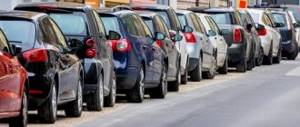Surprisingly, even experienced drivers do not always understand the difference between stopping and parking.
And this despite the fact that the traffic rules carefully consider this issue.
However, motorists often enter into dialogue on this issue with traffic police inspectors, trying to challenge their claims.
The first to suffer in such debates is the car enthusiast’s wallet. Some inexperienced drivers may be deliberately misled by unscrupulous people in uniform.
To avoid such situations, you should know the traffic rules well: stopping and parking are described in detail in the rules, features, similarities and differences are indicated.
Basic concepts of stopping and parking
Stopping and the action called “parking” are similar in that in both cases the movement of traffic stops. The differences lie in the duration of both, and the purpose of performing the maneuvers.
Concepts in traffic rules, differences in designations
The traffic rules explain both terms as follows:
Stop” is a deliberate stop in the movement of a vehicle for up to 5 minutes, as well as for longer if this is necessary for boarding or disembarking passengers or loading or unloading the vehicle.
Parking" is the deliberate stopping of the movement of a vehicle for a period of more than 5 minutes for reasons not related to the embarkation or disembarkation of passengers or the loading or unloading of the vehicle.
There is another significant difference between them. According to traffic regulations, parking is not permitted where stopping is prohibited. But sometimes you can stop for a short time on sections of the road where parking of technical equipment is prohibited.
How many minutes can you stand
The traffic rules describe exactly how many minutes you are allowed to stop driving in each case:
- If the car does this for up to 5 minutes, the driver has completed the stop. He can wait for passengers to disembark or for cargo to be picked up. Or neither one nor the other happens during this time. But if the car was at rest for up to 5 minutes and then moved, it would simply stop rather than park.
- When the vehicle remains in place for more than this time, the action is considered parking. People can get out of it, take out or load things. But if more than 5 minutes have passed, the car has parked.
Sometimes a vehicle stops moving for more than 5 minutes, and this does not mean that it has parked. There is such a term as a forced stop. It can be caused by extraordinary circumstances that make it impossible to travel.
Exceptions and emergencies
Exception by sign 3.27. intended for:
- route vehicles;
- and cars used as taxis.
The specified types of vehicles can stop even in the operating zone 3.27., but only in places specifically designed for stopping them (that is, where there are signs 5.16., 5.17. or 5.18. or markings 1.17.).
Photo: places specially designed for stopping
Regarding index 3.28. there are more exceptions. In particular, the following can stand even within its coverage area:
- Vehicles belonging to Russian Post, which have a white diagonal stripe on a blue background applied to the side surface;
- taxi with a working taximeter;
- cars owned by disabled people of the 1st or 2nd group, as well as cars transporting disabled children (the specified vehicles can deviate from the requirements of 3.28 only if the appropriate identification mark is installed on them - see the picture).
Photo: cars owned by disabled people of the 1st or 2nd group
In addition, drivers can ignore the requirements of the ZZOIS:
- Vehicles with a blue flashing light running, performing an urgent departmental task (Section 3.1. Traffic Regulations);
- A vehicle with an orange or yellow beacon turned on (Section 3.5. Traffic Regulations).
Regarding emergency situations. In clause 1.2. The traffic rules introduce such a concept as a forced stop - this is the cessation of vehicle movement due to a malfunction, the health condition of the driver, passenger, or the appearance of an obstacle on the road.
If a forced stop of driving has to be carried out in the coverage area of the ZZOIS, the driver needs to:
- turn on the emergency lights (paragraph 3, clause 7.1 of the traffic rules);
- be sure to display an emergency stop sign (paragraph 3, clause 7.2 of the traffic rules);
- then take all available measures to remove the vehicle from the place where stopping is prohibited (clause 12.6. Traffic rules).
Road signs "Stop" and "Parking"
Road signs “Stop” and “Parking” also have noticeable differences:
- The first exists only for public transport and is numbered 5.16. It can be supplemented by markup 1.17. Here, ordinary vehicles are prohibited from certain actions: turning around, reversing, parking.
It is undesirable for non-route vehicles to stop even for a short time in the zone of influence of the symbol. This is acceptable when you need to let people out, and the vehicle itself will not interfere with a bus or trolleybus. Here, too, all cars give way to public transport that resumes traffic.
More on AutoLex.Net:
Available about who is giving way in the yard, a sign for entering the yard
- The symbol indicating the parking area is number 6.4 and can be supplemented by signs 8.6.1-8.6.9, which require vehicles to be placed in a certain way. There are parking lots that are public or designated for any category of cars. In the second case, it is also supplemented by the designations 8.4.1-8.4.8, allowing them to be in this zone. The numbers next to 6.4 show that you have to pay to place a car on the territory.
Stopping and parking in populated areas
Stopping and parking of vehicles in populated areas is permissible not only where there are permitting symbols. But there are clear rules here.
Is it possible to stop on the side of the road?
In a city or village, you can stop a car on the side of the road if it is located on the right side of the road. Parking is also permitted here. Paragraph 12.1 of the traffic rules states that vehicles are allowed to be parked parallel to the direction of travel. But prohibitory signs should not be located nearby, and there cannot be any infrastructure features that prevent stopping:
- tram rails;
- railway crossing;
- bridges, overpasses, tunnels;
- sections where the distance between solid markings, the edge of the road and the vehicle will be less than 3 m;
- pedestrian crossing;
- dangerous turn, rise, area with poor visibility;
- lanes for cyclists;
- a traffic light, if it is not visible from behind the vehicle;
- minibus or taxi stops;
- intersection.
You can stop or park on the left side of the road, if we are talking about a passenger car or a cargo vehicle weighing up to 3.5 tons. But only when the path has 1 lane in each direction, or it is generally one-way.
Where is it allowed to stop outside a populated area for a truck?
According to clauses 12.3, 12.4 and 12.5 of the traffic rules, you can stop driving outside the city on the side of the road on the right side if there are no areas and features listed in subsection 12.4 of the “Rules...” nearby.
Long-term parking outside the city for a truck or any other vehicle is permitted only in places equipped for it or where there is no roadway. If you need to park for a short time, this is done everywhere except:
- areas where stopping is prohibited (from clause 12.4);
- on the main road if there is a 2.1 symbol;
- within a radius of 50 m from the railway crossing.
Is it permissible to stop under a bridge?
You can stop under the bridge only if:
- this territory is not under the influence of prohibitory signs;
- there are no features listed in clause 12.4 of the traffic rules.
The building itself is not a place to stop, much less to park vehicles. But the area under it can be absolutely safe, and does not apply to the bridge.
Watch this video about the rules of stopping and parking in populated areas:
Where can I park the vehicle?
On the right side of the road
Let's consider clause 12.1 of the traffic rules:
12.1. Stopping and parking of vehicles is permitted on the right side of the road on the side of the road, and in its absence - on the roadway at its edge and in the cases established by paragraph 12.2 of the Rules - on the sidewalk.
1. If there is a shoulder to the right of the roadway, then cars are allowed to be parked only on the side of the road . If the side of the road is occupied by other cars or something else, then parking cars on the roadway is not allowed.
Area of operation of the “No Stopping” and “No Parking” signs
Symbols 3.27 and 3.28 do not allow you to stop moving. Validity area of "No Stopping" and "No Parking" signs:
- located only on the side of the track where the sign is attached;
- may be regulated by the designation 8.2.2 indicating the length of the territory in meters;
- ends at the nearest road intersection in the direction of travel or at the entrance to or exit from a populated area, if there are no other restrictions before that;
- terminated by symbol 3.31.
Validity area of the “Public Transport Stop” sign
The coverage area of the “Public Transport Stop” road sign is around it or in front of it, since it is placed in the middle or end of this territory. The symbol can be supplemented by the indicator 8.2.1, which reflects its length. Beyond this distance the bus stop ends.
The extent of the zone can also be indicated by marking 1.17. And if the stop is large, symbol 5.16 is duplicated. But the fact that it is always two-way does not indicate its influence on the opposite side of the roadway. There may not be a stop there if the same symbol is missing.
More on AutoLex.Net:
How to interpret the “No U-Turn” sign
Restricted parking zone
An area with a restriction of any duration of parking is indicated by symbol 3.28, but not only. Prohibited actions:
- wherever stopping is not allowed;
- outside the city in the space of influence of sign 2.1;
- at the railway crossing and at a distance of 50 m from it.
In addition, there are also signs that do not allow parking on certain days: 3.29 for odd days, 3.30 for even days. They have the same features as 3.28, but only at the specified times.
There are restrictions for curbside parking. In principle, this is allowed, as the 2nd paragraph of clause 12.2 of the traffic rules says:
Parking on the edge of the sidewalk bordering the roadway is permitted only for cars, motorcycles, mopeds and bicycles in places marked with sign 6.4 with one of the signs 8.4.7, 8.6.2, 8.6.3, 8.6.6 - 8.6.9.
All other types of transport cannot be parked on the sidewalk. But this territory, as an exception, can sometimes be used as a unloading zone. This is allowed by clause 9.9 of the traffic rules:
The movement of vehicles of road maintenance and utility services is allowed, as well as access along the shortest route for vehicles delivering cargo to trade and other enterprises and facilities located directly next to the roadsides, sidewalks or pedestrian paths, in the absence of other access options. At the same time, traffic safety must be ensured.
The main thing is that there are no limiting characters there.
Types of parking
When planning projects for new residential areas, shopping and entertainment centers, industrial complexes, airports, train stations, bus stations, stadiums, shops, it is necessary to allocate space for the construction of parking lots. The calculation of the number of parking spaces occurs at the stage of creating the overall project and is based on strict tolerances of the set of building codes and regulations (SNiP).
Based on the length of time vehicles are stored in a specially designated and equipped area, the following types of parking are divided:
- permanent: usually equipped with everything necessary for a convenient location of the car and payment desks;
- temporary: mostly paid;
- seasonal: organized for a certain time, typical for resort areas, during the construction of large objects.
Based on location they are divided into two categories:
- ground: outdoors, under a roof or indoors, and geographically they can be located in the local area, next to cultural, entertainment, administrative or transport facilities;
- underground: located below level 0.00 under buildings and structures, have a multi-tier structure to maximize the number of parking spaces.
There is great interest in the construction of parking lots on the roofs of buildings, but due to strict safety requirements and a large number of restrictions, their construction is allowed only on low-rise buildings (no higher than 3 floors). In addition, equipping with a large number of additional entrances, elevators and escalators increases the cost of the project. For owners of shopping centers and office buildings, there is an opportunity to earn additional profit by organizing paid parking on the roofs.
“No Parking” sign and its coverage area
The “No Parking” sign has a coverage area in accordance with one of the conditions:
- to the intersection of roads located along the route of cars;
- up to symbols 5.23.1, 5.23.2, 5.25, meaning the beginning of a city or village;
- up to one of the designations 5.24.1, 5.24.2, 5.26, installed at the exit from the populated area;
- until 3.31, signaling that any restrictions have ended;
- until symbol 6.4, meaning that parking starts from here.
In previous cases, it can be installed without an arrow. If 3.28 is supplemented with other symbols, they mean:
- 8.2.2 – length of the segment over which its influence extends;
- 8.2.3 with a down arrow demonstrates that parking is not permitted in front of or after the sign, at a short distance;
- 8.2.4 is attached next to the designation 3.28 in a large area where parking is not allowed;
- 8.2.5 and 8.2.6 show that parking cars is prohibited along houses or on the street.
Locations of the ban
Having learned to read prohibiting and permitting signs, it will be easy for a motorist to stop and choose places to leave the vehicle for a longer period in full compliance with traffic rules.
Where is it prohibited to stop?
The issue of finding places to stop the movement of a car within a populated area is especially acute, where there are many prohibitions and finding a suitable place that does not impede the movement of other participants on the road is quite difficult.
In addition to the road signs themselves, there are certain areas where stopping is not allowed under any circumstances:
"No Stopping" sign and its coverage area
The influence of the “No Stopping” sign extends only to the side of the road where it is fixed. The coverage area may be limited:
- same as territory of influence 3.28;
- the end of a segment where stopping is not allowed by the rules, that is, leaving the bridge, after 5 m from the zebra crossing, etc.;
- completion of markup 1.4;
- additional signs on which the extent of the influence of the symbol is written in meters.
Next to 3.28 there may be a sign 8.24 “A tow truck is working.” It means that vehicles left here will be transported to the penalty area. After all, parking where you can’t even stop is even more prohibited. But if the driver stopped driving the car for less than 5 minutes and did not leave the car, the vehicle will not be taken away. The motorist will simply be fined.
"Regulated parking zone" sign
The “Regulated parking zone” sign 5.29 shows that parking is possible on the territory, but only as prescribed by additional symbols or markings:
- plate 8.6.1 requires parking the car in the direction of travel;
- 8.6.2 allows you to park it along the road with the right front and rear wheels on the pavement;
- 8.6.3 allows parking on the sidewalk, placing the vehicle parallel to the direction of travel;
- 8.6.4 requires that cars be parked at an angle of 90 degrees to the side of the road;
- 8.6.5 requires a location similar to the previous one, but the rear of the vehicle must be facing the roadway;
- 8.6.6 allows you to drive your rear wheels onto the sidewalk, and 8.6.7 allows you to drive your front wheels;
- 8.6.8 will allow vehicles to be parked on the sidewalk, positioned perpendicular to the direction of movement, with the front of the vehicle facing the roadway;
- 8.6.9 is similar to the previous designation, but the vehicle should be parked with its back to the road.
More on AutoLex.Net:
In Russia they want to install smart traffic lights
Only the first of these signs allows trucks, pickups, tractors and other bulky equipment to park in regulated parking lots. All other symbols have no relation to the listed modes of transport. After all, it is possible to leave a vehicle on the sidewalk, even if the front or rear wheels climb there, if it is a passenger car, a motorcycle, a bicycle or a moped.
The territory of action 5.29 is completed by the symbol 5.30.
Traffic rules for “Stop” and “Parking” signs
The traffic rules under the symbols “Stop” and “Parking” not only allow drivers to perform the specified actions, but also prohibit some maneuvers. Under sign 3.27 you cannot:
turn around;- follow in reverse;
- overtake public transport disembarking and receiving passengers, crossing a solid marking line;
- otherwise impede its movement, for example, stop if the bus is following.
In the parking lot it is prohibited:
- position the car contrary to the requirements of the regulatory signs;
- park the car so that neighboring vehicles do not have the opportunity to get out;
- occupy seats reserved for disabled vehicles without any reason;
- open doors, preventing other cars from leaving, creating the danger of an accident;
- leave a child under 7 years old alone in the cabin;
- park without using the gear or handbrake;
- leaving the car door unlocked or the keys in the ignition.
Comparative characteristics
Below we compare the two concepts under consideration according to several basic parameters: payment, responsibility for storage, territory.
- First of all, you should understand that the definition of parking in the traffic regulations does not imply a fee for the service. It can be carried out anywhere: near a shopping center, healthcare institutions, supermarket, etc. But the car should not remain idle for a long time. Typically, this concept is more often applicable to public transport. But an ordinary vehicle can also park near the desired location for boarding/disembarking passengers or loading/unloading goods. Parking, on the contrary, implies the possibility of parking a car in a parking space for a long period of time. For this purpose, there are specialized places near socially significant points. In this case, no payment is required, but there will be no car security.
- Another option for parking and parking is a paid guarded area. In the first case, the motorist must pay a fee to the security company for a certain period, but responsibility for the car remains with the driver (including for personal belongings in the cabin). In the parking lot, different rules apply: for a fee, responsibility for the safety of the car is transferred to the security guard of this territory. That is, if the car is damaged or stolen, the employee will be responsible for this. But such cases occur extremely rarely, since the zone is usually closed and can only be entered through a checkpoint.
- Another important point is that the driver has the right to park only in designated areas. Violation of this order means the imposition of a penalty. A short stop can be made almost anywhere: if the driver is in the car and the engine is not turned off.
What does a driver face for violating traffic rules?
Stopping or parking in places where actions are prohibited leads to the need to apply Article 12.19 of the Code of Administrative Offenses:
| Violation | Fine |
| Took a seat for a disabled person | 5000 rub. |
| Took a place at a pedestrian crossing | 1000 rubles, and for Moscow and St. Petersburg – 3000 rubles. |
| For parking on the sidewalk | 1000 rubles, and for Moscow and St. Petersburg – 3000 rubles. |
| For leaving a car for more than 5 minutes at a public vehicle stop | 1000 rubles, and for Moscow and St. Petersburg – 3000 rubles. |
| For tram tracks | 1500 rubles, and in the capital and St. Petersburg – 3000 rubles. |
| Parking a car in the second row | 1500 rubles, and in the capital and St. Petersburg – 3000 rubles. |
| Parking in a tunnel and obstructing the road | 2000 rubles, and in Moscow and St. Petersburg for both actions 3000 rubles. |
| Stopping and parking under prohibitory signs | 1500 rubles, and in the capital and St. Petersburg 2 times the amount |
| For all other offenses related to a brief interruption of vehicle movement and parking | the driver will receive a warning or 500 rubles. fine |
Parking or stopping at a railway crossing and 50 m from it will result in the need to pay 1000 rubles. or deprivation of driver's license under Part 1 of Article 12.10.
The ban on briefly stopping traffic in some places and parking there is primarily related to road safety. It also dictated the requirement to refrain from risky maneuvers in parking lots or stops. It is sometimes difficult to fulfill the conditions, but it is necessary to do this for the sake of preserving your car, health, and sometimes life.
Construction pitfalls
Organizing effective parking requires certain experience and competent work of a whole team of highly qualified specialists. The most cost-effective option would be to organize an automated system, since the availability of a full set of equipment for collecting funds, accessing the parking lot, moving around its territory and placing vehicles in parking spaces will significantly reduce the cost of maintaining personnel and eliminate the impact of the human factor.
For construction, you will need a project that must be completed at a highly professional level and take into account all the nuances. Errors and shortcomings in the future can lead to additional improvements and significant financial losses. It is best to order equipment and accessories for full operation from specialized companies, giving preference to manufacturers.
Obtaining permits from government agencies requires a lot of effort, time and finances. In conditions of intensive construction and increased urban congestion, it is very difficult to agree on a territory for the organization of guarded parking lots. In addition, issues with connection to existing utility and road networks will have to be resolved. Many owners of future facilities turn to specialized companies that solve all organizational and technical issues in a comprehensive manner. This significantly saves time and financial costs.
One of the indicators of the efficiency of future parking is the maximum capacity. This factor is directly related to profit generation and the payback time of the automated system, so organizing an underground option would be the most profitable. Such a system occupies a minimum area, and a large number of tiers will provide maximum capacity.
A complex approach
The ParkCity company has been professionally engaged in the design, production, installation and subsequent maintenance of automated parking systems for more than 10 years. Qualified specialists with extensive experience will develop a project taking into account the wishes of the customer and the individual characteristics of the future parking lot, supply and install all the necessary equipment for the effective functioning of the automated system, carry out commissioning work and train personnel to operate the equipment and devices.








